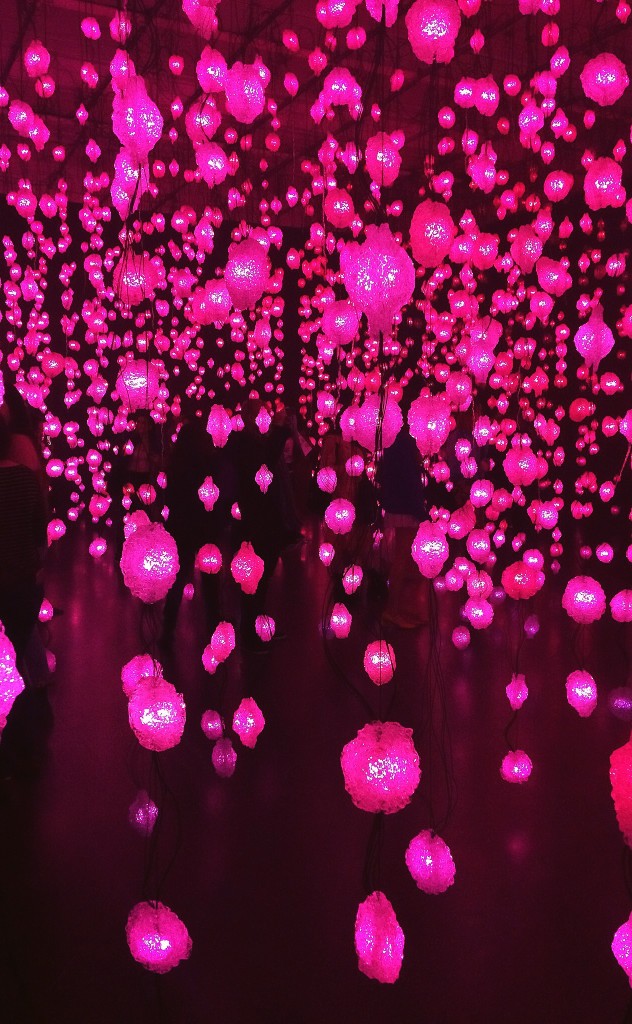Technological Magic in the Age of Instagrammable Art: Pipilotti Rist’s “Pixel Forest”
 Swiss-born Pipilotti Rist’s synesthesia-inducing “Pixel Forest” opened Wednesday, November 2 at the New Museum. The exhibition is comprised of three floors of effervescent tactility, featuring underwear chandeliers and double screen videos revealing a juxtaposition of aureole-macro shots with underwater aqueous scenes. The focus of Rist’s “Pixel Forest” is on video art, but the installations pursue a delightful, voyeuristic quality that can be found as visitors wander through the exhibition. There is certainly an Alice-in-Wonderland quality to Rist’s multidimensional worlds.
Swiss-born Pipilotti Rist’s synesthesia-inducing “Pixel Forest” opened Wednesday, November 2 at the New Museum. The exhibition is comprised of three floors of effervescent tactility, featuring underwear chandeliers and double screen videos revealing a juxtaposition of aureole-macro shots with underwater aqueous scenes. The focus of Rist’s “Pixel Forest” is on video art, but the installations pursue a delightful, voyeuristic quality that can be found as visitors wander through the exhibition. There is certainly an Alice-in-Wonderland quality to Rist’s multidimensional worlds.
Elizabeth Charlotte Rist was born in the Rhine Valley in 1962 to an upper-middle-class Swiss family, but changed her name to “Pipilotti” as an homage to her childhood nickname “Pippi,” derived from Pippi Longstocking. From the beginning of her career as an artist, Rist sought to meld the external world with the world of art, using video as her desired medium. The artist studied graphic design, illustration, and photography at the University of Applied Arts in Vienna, but shifted to the audiovisual realm when she attended the Basel School of Design. She has presented solo exhibitions at Kunsthaus Zurich (2016), Kunsthalle Krems in Austria (2015), the Times Museum in Guangzhou, China (2013), the Samsung Museum of Art in Seoul, South Korea (2012), the Fondazione Nicola Trussardi in Milan, Italy (2011), the Centres Pompidou in Paris, France (2007) and even had a retrospective at MoMA in 2008.
I entered Rist’s “Pixel Forest,” curated by Massimiliano Gioni, by taking the mirrored elevators of the New Museum to the fourth floor. Rist’s 1997 “Ever Is Over All” occupied the left side of the back wall and the rest of the floor provided an assortment of visceral pleasures including videos projected onto fabrics. The film featured a double screen revealing a woman shattering glass windows with a floral instrument. Visitors sifted through sheath layers of macro pastorals to arrive at the “Ever Is Over All” installation. I threw myself upon one of the numerous floor pillows coating the plush floor and watched the film in it’s entirety. Although perhaps not intentional, Rist’s “Pixel Forest” is exemplary in proving the success of the “installation piece” in the Age of Instagrammable Art. Rist’s survey includes a dreamy chandelier made from undergarments illuminated by shifting pastel lights. A maze of chunky fairy lights hang from the ceiling glowing in oscillating hues, a tiny post-apocalyptic dollhouse projects light across the dark room.
Most notably “Instagrammable” perhaps is Rist’s “4th Floor to Mildness,” an installation wherein visitors are invited to discard their shoes and recline on secondhand beds provided by the New Museum so that they can view screens on the ceiling. These screens depict dreamy footage of swimming in the Rhine (a nostalgic image for Rist, who swam in the Rhine as a child) contrasted with sensual imagery of nipples and thighs. The videos are set to music by Austrian artist Anja Plaschg of Soap&Skin.
Although Rist’s “Pixel Forest” presents visitors with a dichotomy between sin and the sublime via her amalgam of controversial and mundane imagery, the artist has a positive outlook on the future of our society. She is “hopeful about the state of everything,” and one can find examples of said mindset incorporated into multiple parts of her exhibition. A sense of eclectic warmth is cultivated by the coziness of her lush viewing platforms, in the incandescence of her luminescent labyrinth, and in the sheer sense of adventure that accompanies the visitor’s experience.
Curator Gioni compared the viewing of the show to Monet’s “Water Lilies, except from the other side, below the surface.” At this conjecture I draw a comparison between Rist’s utopian “Pixel Forest” and the dystopian anomaly of the “Upside Down” from Netflix phenomenon Stranger Things. Nevertheless, “Pixel Forest” is a must-see sensual wonderland that raises interesting inquiries concerning technology’s intersection with reality, and how we can perhaps view reality from a new perspective.
